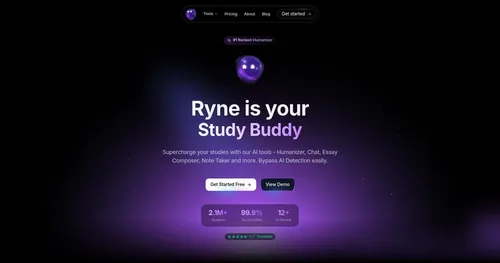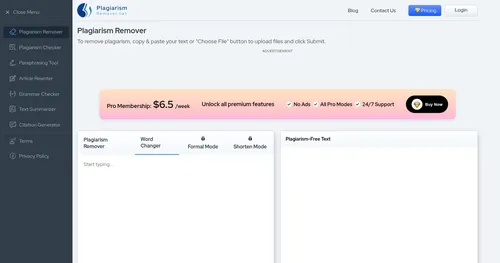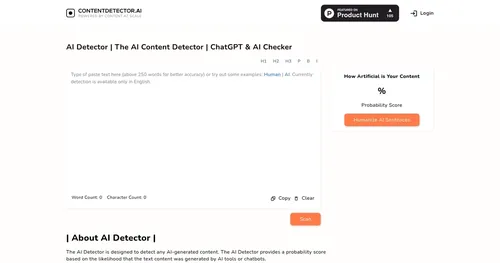EssayFlow
EssayFlow is an AI-powered essay generator designed to produce undetectable, human-like academic writing that evades popular AI detection tools. It supports various formats including essays, research papers, dissertations, and literature reviews, generating content based on user-specified topics, types, languages, and lengths. The tool operates through a three-step process: inputting details, optionally enabling Undetectable Mode for enhanced human mimicry, and generating with a built-in detectability check.
The core model trains on millions of high-grade human-written essays, enabling it to replicate natural writing patterns such as varied sentence structures and idiomatic phrasing. This training data ensures outputs maintain academic rigor while avoiding robotic repetition. Integration with detectors like GPTZero, ZeroGPT, Originality.ai, Turnitin, Winston AI, and Copyleaks provides comprehensive AI score reports post-generation, confirming low detection risk.
Key features include one-click generation or step-by-step building, plagiarism-free originality guarantees, and multi-language support. Undetectable Mode adjusts output metrics like perplexity and burstiness to align with human baselines, using advanced natural language processing techniques. Pricing follows a freemium model with paid upgrades for unlimited access, generally competitive against alternatives like Jasper or Sudowrite, which focus less on academic evasion and offer similar or higher costs for comparable functionality.
Users appreciate the tools efficiency in overcoming writers block and its accuracy in structured arguments, though some note limitations in handling highly niche topics without refined prompts. Competitors such as Jasper excel in creative writing but lack specialized academic training, while Sudowrite suits fiction over essays. EssayFlow stands out for its targeted anti-detection capabilities and integrated verification.
For optimal use, provide detailed prompts incorporating specific angles or sources to enhance relevance. Test outputs on personal detectors before submission, and iterate generations to refine tone and depth, ensuring alignment with individual writing styles.
Video Overview ▶️
What are the key features? ⭐
- Undetectable Mode: Activates adjustments to mimic human writing patterns, evading AI detectors like GPTZero and Turnitin.
- AI Detection Score Report: Scans generated content against multiple detectors for comprehensive undetectability scores.
- Multi-Format Generation: Supports essays, research papers, dissertations, and literature reviews with customizable lengths.
- Originality Checker: Ensures plagiarism-free output by verifying uniqueness against common sources.
- Step-by-Step Builder: Allows iterative content creation for refined, tailored academic writing.
Who is it for? 🤔
Examples of what you can use it for 💭
- College Student: Generates a persuasive essay on climate policy, checks undetectability, and refines for submission.
- Researcher: Builds a literature review on AI ethics, ensuring originality and human-like flow for journal drafts.
- High Schooler: Creates argumentative pieces on historical events, using step-by-step mode to learn structure.
- Professor Assistant: Drafts dissertation chapters with specific prompts, verifying against multiple detectors.
- Freelance Writer: Produces academic-style reports in non-English languages, maintaining cultural nuances.
Pros & Cons ⚖️
- Evades top detectors
- Human-like output
- Fast generation
- Plagiarism-free
- Free tier limited
- Needs good prompts
FAQs 💬
Related tools ↙️
-
 Ryne
An easy-to-use tool designed to make AI-generated text sound more human
Ryne
An easy-to-use tool designed to make AI-generated text sound more human
-
 AI Undetect
Assisting users in refining AI-generated content to make it like human-written text
AI Undetect
Assisting users in refining AI-generated content to make it like human-written text
-
HumanizeAI.com Converts AI-generated text into natural, human-like content that bypasses AI detectors
-
 Turnitin
An educational platform that uses advanced AI to ensure academic integrity by detecting plagiarism
Turnitin
An educational platform that uses advanced AI to ensure academic integrity by detecting plagiarism
-
 PlagiarismRemover.net
An AI-driven tool that helps eliminate plagiarism from various types of content
PlagiarismRemover.net
An AI-driven tool that helps eliminate plagiarism from various types of content
-
 ContentDetector.AI
Copy and paste the content to check whether the AI generated it
ContentDetector.AI
Copy and paste the content to check whether the AI generated it

